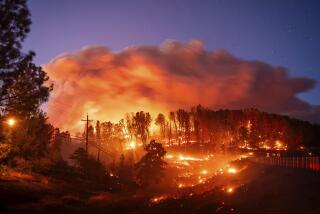Bonfire fans won’t let beach tradition die out
The sun is sinking over Bolsa Chica State Beach when the cars begin their nightly swap. Out go the boys hauling bodyboards, the sun-blistered tourists, the girls in huge shades and bikinis the size of washcloths. In drive the locals, carrying memories of summer nights spent beside the Pacific, huddled around a bonfire, toasting s’mores.
Near lifeguard stand 21, Ben Garcia leaned as close as the flames allow. He spent nearly an hour cramming his girlfriend’s Ford Explorer with scrap lumber to torch and squirmed through work, his mind already at Huntington Beach. When he and his buddies rushed to the sand, they spread a faded comforter and unloaded potato salad. Their day at the beach began as the moon rose above the palms.
Bolsa Chica State Beach, a three-mile strip across Pacific Coast Highway from its namesake wetlands, is among a handful of California shorelines clinging to an iconic tradition: the beach bonfire. Over the years, many beaches have banned fires because of safety or air quality concerns and shrinking maintenance budgets.
Of the 108 coastal strips run by the state parks department, 29 allow fires. The Los Angeles County Department of Beaches and Harbors, which oversees most of the county’s coastline, maintains fire rings only at Dockweiler Beach in Playa del Rey. Fire pits have been yanked from Del Mar beaches in San Diego County. Many of the remaining beaches have imposed curfews.
The fire-friendly beaches remain settings for birthday and graduation parties, end-of-summer barbecues and uniquely coastal Thanksgiving celebrations. In movies and television, they are shorthand for Southern California, backdrops to angst and heartbreak in multiple episodes of “The O.C.” and “Laguna Beach: The Real Orange County.” And they are zealously defended.
State parks officials in Santa Cruz County considered barring fires -- and quickly backed off when the community objected. At San Francisco’s Ocean Beach, the National Park Service lacked staff to pick up nails, glass and hot coals left over from the fires. But when officials tried to ban them, the agency was deluged with angry e-mails. The park service finally accepted an offer from the local Surfrider chapter to clean newly installed fire pits weekly.
“There is just something about going from a sophisticated West Coast city and going to the beach and sitting under the stars and seeing the waves,” said Rudy Evenson, Ocean Beach’s community liaison.
In May 2002, state parks officials in Orange County announced that budget cuts would force them to close all fire pits. There was such an uproar that the plan was shelved the next day.
“No more sitting on the beach at night, loved one in your arms, gazing out at the crackling fire and listening to the waves pounding on local state beaches?” the Orange County Register wrote. “That wasn’t just a stupid idea, and a case of government bungling, but an assault on our Southern California lifestyle.”
Huntington Beach, with at least 600 rings, may be Southern California’s beach fire capital. The city Conference and Visitors Bureau devotes an entire page of its website to the fires and peppers its visitors guide with photos of them. Its film-location website touts the concrete fire rings as a highlight of the city beach’s southern end.
Beachgoers crowded around a campfire, silhouetted against the night sky, “are iconic images that embody Huntington Beach,” said Doug Traub, the bureau’s president and chief executive. “There probably isn’t a family in this town that hasn’t been to a beach bonfire.”
For Bolsa Chica State Beach, which attracts 400,000 visitors each summer month, an information line warns against torching pallets or Christmas trees. On a recent weeknight, beachgoers shuffled to half a dozen pits imprinted with “Caution: Hot Ashes.” The seating ranges from beach towels to pricey pop-up tents. Mothers yell “Please” and “Por favor” when begging kids to stop throwing sand. The rituals of a nighttime beach unfold.
Joshua Smith and his friends nestled under blankets in folding chairs, watching their alder logs burn. Aided by napkins, cardboard boxes and fast-food wrappers, the fire had crackled through hours of bratwurst roasting. Smith’s friends laughed as their 3-year-old son dashed toward the waves, only to get scared and scamper back.
Smith, a 26-year-old waiter, has a theory, and the group groans when he shares it: “We’re nature. This is nature. This is where we should be.”
“But a house is warm,” one friend protests.
“A house is where you sleep in,” he says. “You need to be out in the sunshine. When it rains, you can stay in and watch TV, but it’s not right otherwise.”
The conversation lapsed. The wind teased hair and snatched baseball caps. Garcia, his two buddies, his girlfriend and her kids hunched over their fire, recounting their flubs. They forgot the beach chairs, so Karrissa, 12, and Brandon, 8, made benches by pounding the scrap planks into the sand. Garcia’s co-worker, Michael St. Pierre, brought fluid meant for cigarette lighters, not campfires. No matter. The wood, leftovers from construction of a backyard patio, sputtered in the fire.
It reminded Garcia, 30, of the Saturdays when his family drove from Cerritos to this very beach. They whiled away hours tossing Frisbees and digging holes. Garcia’s younger brother would tiptoe near the water but refuse to wade in. Garcia would splash him. Or whack him with a ball.
The day’s climax, always, was the fire. Garcia’s buddies chime in wistfully with their own tales of beach blazes and fire-walking fraternity brothers. That’s when St. Pierre spied the moon, so orange it looked Hollywood-produced.
“When did it get dark?” asks Garcia, who had lost track of time. He was determined to stay until his wood pile turned to embers, lengthening by a few more hours one of summer’s final days.
More to Read
Sign up for Essential California
The most important California stories and recommendations in your inbox every morning.
You may occasionally receive promotional content from the Los Angeles Times.










